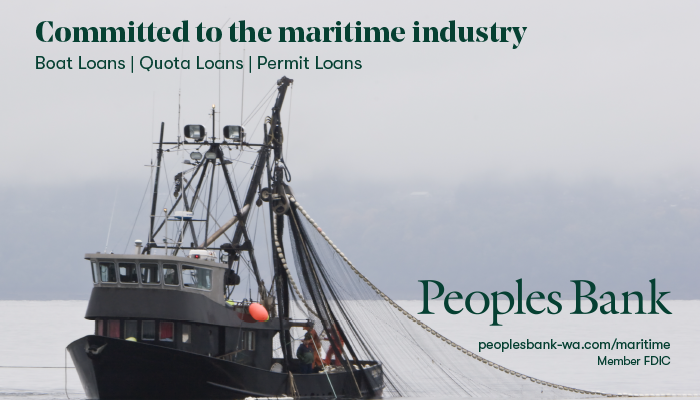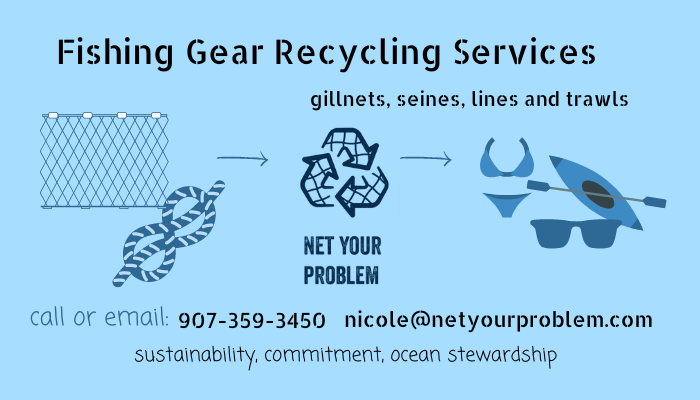Fish Factor by Laine Welch
May 22, 2021
Grundens is using recycled plastics from old fishing gear for a new line of rugged casual wear, and the first batch contains contributions from Cordova.
Grundens, whose motto is “We are fishing,” is the go-to brand for outer wear and foul-weather gear for mariners around the world. The company, which originated in Sweden in 1911, debuted its NetSource Collection this spring. The men’s shorts and women’s leggings use ECONYL, a regenerated nylon fabric that uses recycled fishing nets as the raw material.
The company connected with the Copper River Watershed Project which collects the fishing nets and prepares them for shipping to Europe, where they are recycled into plastic pellets or, in this case, fibers.
“We believe it's really important to use our brand voice to help protect and maintain healthy marine environments and to lend a hand where we can,” said Mat Jackson, Grundens chief marketing officer. At some point, you’ve got to just start doing it. And Cordova seemed like a tangible opportunity.”
“Cordova is moving full steam ahead,” said Nicole Baker of Net Your Problem who helped make the Grundens connection. Baker, a former Bering Sea fisheries observer, has helped jumpstart fishing gear recycling programs in Alaska since 2017.
“The gill net fleet is pretty dialed in and seines are made out of the same type of plastic, so those two gear types can be recycled together,” she added.
“Right now, it's just a small part of our overall collection, but we seek to expand it to other items, including foul-weather gear. It’s something we really believe in,” said Grundens spokesman Corey Lowe.
“We’re aware of the amount of ghost nets and plastics in the ocean so whether we're doing it or our competitors, we want more of it to end up in the recycling supply chain. We see it as a rising tide lifts all boats kind of thing and positive for the industry overall,” Lowe said.
He added, “Hopefully, when fishermen buy something from us later on, it’s kind of cool to think hey, my net is now hanging off my shoulders as a jacket or something.”
Grundéns also is now using 100% biodegradable packaging called PLA whose raw material is glucose from corn starch. It fully decomposes in under one year. By June 2021 all products will be shipped in compostable Eco-packaging. “Grundéns encourages other brands to follow suit and increase the rate at which plastic poly bags are eliminated from the apparel supply chain,” a press report said.
Recycling road trip - Grundens also has its eye on old fishing gear from Bristol Bay, where the borough will discuss a funding request from Net Your Problem at its June 7 meeting.
Founder Nicole Baker said she had “tentative commitments” from the Regional Seafood Development Association, the Bristol Bay Economic Development Council and Grundens to help pay for the first year of recycling there.
“If that gets approved, cross our fingers, we will be able to start in 2022,” Baker said.
She and team members also will be in Cordova on June 8 to and in Homer in mid-June to talk with people about getting a program going there. They will head to Dutch Harbor on June 18.
“We're going to be working with the City to sort through the landfill and recycle what we can, and also to push for the boats to do recycling,” Baker said.
In Southeast Alaska, Friends of Recycling in Haines is collecting fishing nets and RecycleWorks in Juneau is doing the same at Aurora Harbor. Kodiak is still accepting trawl nets and “things are in the works” for other gears, Baker said.
The Dillingham program is defunct, Baker said, and the landfill there doesn’t accept fishing nets.
“I'm hoping that those two forces will encourage fishermen and other businesses to work with us to get something going again,” she said.
Baker is doing a survey to estimate the amount of fishing gear available for recycling in Alaska and said “every single fisherman with the exception of one has said they think recycling is a better option for their gear than the landfill.”
The problem, she added, is “how do we pay for it. Do our values and morals align with what budgets we have and other alternatives costs?”
Much of it falls to human behavior.
Net Your Problem is one of 10 finalists in a global “Solution Search” competition for solutions related to plastic pollution that rely on behavior changes.
It is sponsored by the Center for Behaviour and the Environment and the winning entrant receives a $25,000 grant. Project supporters can vote once per day through June 11.
Dutch does it again – Dutch Harbor easily held on to the title of the nation’s top fishing port, Naknek laid claim to #2 in terms of dollars crossing the docks and salmon toppled lobster as America’s most valuable fish.
Those are a few takeaways from the Fisheries of the U.S. report by NOAA Fisheries for 2019. It also covers trade, mariculture and more for nearly every fish in the sea and is loaded with colorful graphics. A snapshot:
Dutch Harbor was the leading port for fish landings for the 23rd year running with 763 million pounds worth $190 million.
The Aleutian Islands, home to North America’s largest processing plant at Akutan, ranked second (589 million pounds/$142 million) and Kodiak placed third for landings (397 million pounds/$120 million).
For value, New Bedford, Massachusetts held on to the top spot for 20 years at $451 million, due to landings of pricey scallops.
Naknek ranked second for catch value at $289 million for 206 million pounds, followed by the Aleutians ($149 million), Bristol Bay ($129 million) and Kodiak ($120 million).
Eight Alaska ports (40%) were in the top 20 for both seafood landings and values and accounted for 24% of the top 50.
Of all the seafood species caught by U.S. fishermen, Pacific salmon had the highest value at $707 million for 840 million pounds. Alaska accounted for 99 percent of the total U.S. salmon catch.
The average salmon price to Alaska fishermen was 81-cents a pound, down from 99-cents in 2018.
Alaska pollock was tops for fish that is processed into fillets and other forms (1.6 billion pounds/$2.2 billion). Second was sockeye salmon (211 million pounds/$1 billion).
In all, U.S. fisheries produced 9.3 billion pounds in 2019 worth $5.5 billion, on par with the previous year.
Sixty percent of the U.S. catch and 33% of the value were generated by Alaska fisheries.
The U.S. imported 6 billion pounds of seafood ($22.2 billion) and exported 2.8 billion pounds ($5.2 billion) for a trade deficit of $17 billion.
For recreational fisheries, spotted trout was the #1 catch by U.S. anglers, followed by black sea bass and bluefish.
And Americans ate a bit more seafood - 19.2 pounds per person, up two-tenths from 2018.
Salmon watch - At Copper River’s second opener on May 20, New Peter Pan Seafood paid $12.60 per pound for sockeyes and $19.60 for kings, an all-time high. Peter Pan Vice President of Operations Jon Hickman said, “leaders at Peter Pan are looking forward to being a foundation for all fishermen, communities and the market.”






